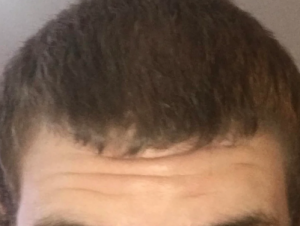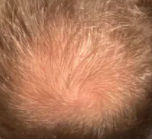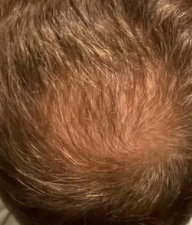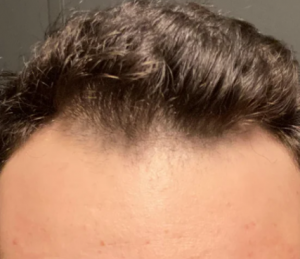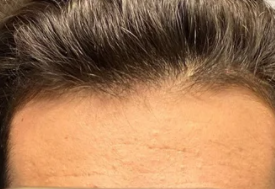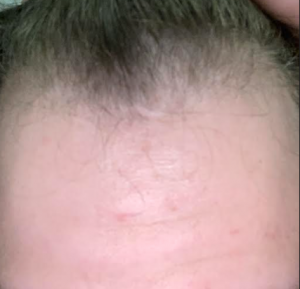Although you did not pull your hair back, it looks like the hairline is close to the highest crease of the furrowed brow meaning that it has not receded yet to a mature position. If you want a more exacting answer from me, show me a photo, full frontal face, with your hair pulled back and your eyebrows lifted high so that the forehead shows. This will give me an anatomic reference for where your hairline belongs.
There is so much fear mongering around it, but the chances are so slim that you will ever have permenant side effects. It will honestly take such a weight off your shoulders knowing your hair loss has been halted or at least significantly slowed. So just take it already, forget about your hair loss and live.
Life is too short to spend every second worrying about your hair. It is one aspect of who you are. Even if fin/dut doesn’t work for you all it means is a different haircut. And if anyone doesn’t like you for being bald then cut them out of your life.
Assuming that Post finasteride syndrome is real, I advise patient that if they get sexual side effects, to stop the medication. The alternative oral minoxidil is a reasonable choice followed by topical finasteride.
I’ve had intense shock loss that seems to have accelerated the balding; I’m now noticeably thin much farther up my hairline than pre-op. There’s minimal growth and this past week the native shed accelerated.
Shock loss usually occurs in men under 35 and only on the first surgery because it kicks out miniaturized hairs. If after a year a second surgery is done, shock loss often doesn’t happen. Shock loss can be prevented by the use of finasteride in most cases.
Sometimes I get a decent amount of hair in my brush or when applying product to my hair, and I get worried that I’m accelerating any balding I have.
If you brush a little rough and tug some hair out, will it grow back? I would think that it should, since the follicle it came from is still alive, right?
With vigorous brushing, you can pull out the miniaturized hairs that might not come back. For styling, use a large toothed comb or brush and that produces the least damage
Thats what i thought too, 5mg was too Much. Im guessing the decrease in dosage won’t affect any hair gains ive made? Currently on my 6th month, just coming off of a shed. I am now taking 2.5mg daily.
The original Merck studies showed that increasing dosage above 1mg, didn’t have an impact on hair growth. The higher dose might increase side effects.
i had hope that maybe back/ shoulder hair has their own cycle and might go to telogen and the hypertrichosis would go away then
All hairs eventually go into telogen and others that are in telogen now will come out into anagen. The minoxidil will impact the new anagen hairs as well
Should I look for PRP to address this problem? I am 17 years old, too young to have this much hair loss and I am panicking.
Your best bet would be to go on finasteride as you are in the age range where this drug might reverse the process. Adding minoxidil will also help. PRP is expensive and is not predictable with little to no benefits on the frontal hairline
During clinical trials, hair loss was seen in somewhere between 1/100 to 1/1,000 participants, so yes it can but it is not commonly found in most people
No, finasteride doesn’t stop beard growth.
https://mail.google.com/mail/u/0/?tab=wm#inbox/WhctKKXPdjMnCLndGrbsnkbGnnPCchLZWrmjvJlcdZBdJCqsqTgSlKfxBlwbwtrklbQSZQq
Conclusion: The results of this study demonstrate the daily administration of a standardized nutraceutical is effective in improving visible hair growth, volume/thickness/fullness, and coverage with less noticeable hair shedding for men and women of various ethnic backgrounds. Many self-assessment parameters continued to improve at Week 24 suggesting additional improvement may occur with continued product use.
You have Cutis Verticis Gyrata. which is a medical condition usually associated with thickening of the scalp. People show visible folds, ridges or creases on the surface of the top of the scalp. The number of folds can vary from two to roughly ten and are typically soft and spongy. (Wikipedia)
Click on the Photo
Well, I guess this puts the scalp tension theory to bed from tressless
This was a complication arising out of a hair transplant performed by unskilled technicians in Turkey. The patient most likely was a smoker. This complication is called ‘Necrosis’ which means in this situation, all of the skin in the area that is now an open crater has died. Fortunately, he either sloughed off the dead skin or a surgeon removed it. I will eventually heal with a huge scar and transplants into the scar may correct the defect after everything has settled down.
I’m 22 and was looking through my old photos. I noticed even as a kid, I had a high uneven hair line. I was also looking at my photos from about 4 years ago, when I first noticed that I couldnt spike my hair up anymore due to my hair thinning on my crown (so the hair on my crown would just fall or not even go up in the first place when I tried spiking it).
The thing is, my hairline is still pretty much the same (maybe a tiny bit higher, but it could just be from maturing). My crown is also maybe about the same, but possibly just a little bit thinner. I can see my scalp through my hair and especially when I use flash, but again its not really that much worse than 4-5 years ago.
It just feels like after 4-5 years it would be more progressed if it is balding.
Is it possible to just have naturally thin hair without actually balding?
Men have hair thicknesses from very fine to coarse. You can inherit very fine hair and have a normal see-through appearance rather than the full look of the coarse haired individual. There are hair thickeners that you can use to make your hair look fuller. Speak with your stylist for the best ones.
Page 117 of 641

